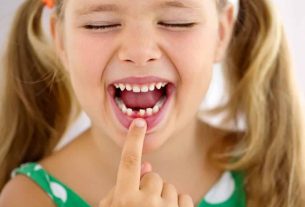Os healthy snacks for kids are essential for its full development. However, they are not always willing to eat this type of food.
With this in mind, we created this guide with 30 ideas for healthy snacks for children, a list of foods for them to avoid and practical tips on how to encourage little ones to eat better.
Keep reading!
Healthy snack: what is it and why is it important?
One healthy snack for kids it must be balanced, nutritious and attractive to children’s palates.
With that in mind, some snack suggestions are:
- Fresh fruit: apples, bananas, grapes, strawberries and watermelon slices are delicious and vitamin-rich options.
- Vegetables with Yogurt Sauce: Baby carrots, cucumbers or celery sticks accompanied by yogurt sauce are a delicious way to include vegetables in your diet.
- Cheese and Whole Grains: a piece of cheese accompanied by whole-grain crackers or whole-grain bread is a nutritious combination.
- Yogurt with Fruit and Granola: natural or Greek yogurt with pieces of fresh fruit and a touch of granola provides protein and fiber.
- Chicken or Turkey Sandwich: A sandwich with lean chicken or turkey breast, lettuce and tomato on whole grain bread is a satisfying option.
- Fruit Smoothie: Blend frozen fruit, yogurt and a splash of juice to create a nutritious and refreshing smoothie.
- Boiled eggs: Rich in protein, boiled eggs are an easy and healthy option.
- Hummus with Vegetable Sticks: hummus is an excellent source of protein and fiber. Serve with carrot, cucumber or celery sticks.
- Mix of Dried Fruits and Nuts: a mixture of raisins, dried apricots, almonds or walnuts offers a variety of nutrients.
- Homemade Popcorn: prepared without excess butter and salt, popcorn is a lighter snack option.
Remembering that the variety It is essential to ensure that the child receives a full range of nutrients.
Furthermore, it is important to consider possible dietary restrictions e individual preferences. Therefore, always consult a healthcare professional or nutritionist for personalized guidance.
See also | Understand the differences between natural and processed foods
How important is a healthy snack?
A healthy snack plays a crucial role in children’s development and well-being. Here are some reasons why this all matters:
- Essential nutrients: Healthy snacks provide essential nutrients, such as vitamins, minerals, proteins and fiber, essential for proper growth and development.
- Sustainable energy: Balanced snacks help maintain stable energy levels, avoiding blood sugar spikes followed by crashes, which can impact focus and cognitive performance.
- Learning support: Well-fed children have greater ability to concentrate and learn. Nutrients like omega-3s and iron are particularly important for cognitive development.
- Weight control: Providing healthy snacks helps teach balanced eating habits, contributing to weight control and preventing food-related problems.
- Healthy eating habits: Offering healthy options from an early age can influence future eating habits, promoting more balanced choices in adult life.
- Taste development: Exposing children to a variety of healthy foods helps develop their sense of taste from an early age, making them more likely to enjoy a wide range of foods.
- Immunity Support: Nutrient-rich foods like fruits and vegetables strengthen the immune system, helping to protect children against disease.
- Prevention of diseases: A healthy diet in childhood is associated with a reduced risk of developing chronic diseases, such as type 2 diabetes and heart disease, later in life.
- Adequate hydration: Healthy snacks can include hydrating options, such as fruits with a high water content, helping to maintain hydration.
- Establishment of routines: Offering healthy snacks at regular times helps to establish eating routines, promoting a healthy and structured environment.
Therefore, choosing healthy snacks not only meets immediate nutritional needs, but also lays a solid foundation for children’s long-term health.
See also | New food label? Understand what the main changes will be
30 healthy snack ideas for children
We have also separated a list of 30 ideas for children’s snacks by product categories.
Look.
Fruits and vegetables
- Carrot and Hummus Sticks: a tasty and nutrient-rich combination.
- Apple with Peanut Butter: offers proteins and fiber.
- Fresh Fruit Mix: variety of colors and flavors.
- Fruit and Yogurt Smoothie: a refreshing and nutritious option.
Cereals and Grains
- Oatmeal Bowl with Fruit: fiber and energy for the day.
- Yogurt with Granola: crunchy and creamy textures.
- Whole Corn Popcorn: a healthier alternative.
- Homemade Cereal Bar: control of ingredients and no additives.
An extra tip is worth here: for those looking for quality cereals and grains, including for children who have some dietary restrictions, the Taina Alimentos is the best suggestion.
With its rigorously applied food safety protocols, the food produced by the industry is completely free from cross-contaminationbringing more and more safety and health to those who consume them.
To find the range of products from Taina Alimentosjust access the website.
Savory Options
- Cheese with Grape Grains: balance of flavors.
- Chicken and Vegetable Wrap: a portable meal.
- Wholemeal Toast with Avocado: rich in healthy fats.
- Cheese Sticks with Cherry Tomatoes: simple and delicious.
Sweet Options
- Yogurt with Strawberries and Honey: naturally sweetened.
- Oatmeal Raisin Cookies: a healthier version.
- Banana with Dark Chocolate: Satisfies your sweet tooth.
- Muffin Integral de Banana: source of fiber.
Tasty Alternatives
- Turkey and Pineapple Sandwich: sweet and sour.
- Ham and Cheese Rolls: protein and calcium.
- Brown Rice Bowl with Vegetables: essential nutrients.
- Banana Pancakes: small and delicious.
Practical Options
- Yogurt Ice Cream with Fruit: refreshing and healthy.
- Trail Mix with Dried Fruits and Nuts: fast energy.
- Mini Wholemeal Bread Sandwiches: variety of healthy fillings.
- Cheese Cubes with Tomato and Basil: caprese inspiration.
Grain Options
- Cauliflower Rice: a light alternative to traditional rice.
- Quinoa Couscous with Vegetables: rich in proteins.
- Wholemeal rice cake: Great way to reuse leftovers.
- From Zucchini Noodles: low calorie and rich in fiber.
Options to Take to School
- Mini Sandwiches with Carrot Bread: colorful and healthy.
- Fruits Cut in Fun Shape: stimulates children’s interest.
Remember to adapt the portions according to the children’s age range and individual preferences.
Foods for Children to Avoid
Discover now the list of foods that children should stay away.
Fast Food and Processed Food
Burgers, nuggets and frequent fries can be high in saturated fats and sodium. Learn how to identify these items on a label here.
Soft drinks and sugary drinks
They contribute to increased sugar consumption, which can impact dental health and weight.
Sweets and Candies
In addition to the negative impact on sugar, they can be harmful to your teeth.
Industrialized Cakes and Biscuits
They often contain large amounts of sugar and saturated fats.
Industrialized Snacks
Typically, it contains high levels of sodium and unhealthy fats.
Foods Rich in Trans Fats
Present in some processed foods, they can be harmful to cardiovascular health.
Sugary Cereals
Some breakfast cereal options may contain high amounts of added sugars.
Commercial ice cream
They may contain additives, colorings and significant amounts of sugar.
Processed sausages
Sausages, hams and other processed sausages can have excess sodium and additives.
Spicy or Very Spicy Foods
They may not be well tolerated by children’s digestive systems.
Foods with Caffeine
Coffee, black tea, cola drinks may not be suitable for young children.
Preserved Fruits with Added Sugar
Choose fresh fruit or fruit in your own water.
Ready Sauces with High Sugar and Sodium Content
Pasta sauces and other industrialized condiments may contain excess sugar and sodium.
Foods That Can Cause Choking
Such as popcorn, whole nuts, or very hard foods for young children.
Energy Drinks and Caffeine Supplements
They are generally not suitable for children.
Remembering that each child is unique and some dietary restrictions may vary based on individual health, allergies and preferences.
It is always advisable to consult a pediatrician or nutritionist for personalized guidance.
How to encourage children to eat healthy? 15 practical tips
Is it difficult to convince your little one to eat better? See practical tips on how this can be possible below.
- Involve children in preparation
Include them in the meal preparation process. This can spark interest in food.
- Present variety of foods
Offer a variety of fruits, vegetables, proteins and grains to ensure a balanced diet.
Children often imitate adult behavior. Be an example by eating healthily.
- Create fun meals
Use creativity when presenting dishes. Fun shapes or colorful arrangements can make meals more attractive.
- Don’t force, but offer
Avoid forcing children to eat. Offer food and allow them to explore new flavors at their own pace.
- Associate foods with characters or stories
Create positive stories or associations with healthy foods to make them more interesting.
- Schedule regular meal times
Establish consistent times for meals and snacks, creating an eating routine.
- Encourage adequate hydration
Water is essential. Encourage regular consumption throughout the day, especially during meals.
Take the kids to the supermarket and involve them in choosing healthy foods.
- Involvement in outdoor activities
Physical activities and outdoor play can stimulate appetite and promote healthy habits.
- Reward with praise, not food
Praise efforts and healthy choices instead of using sweets or snacks as rewards.
- Promote social engagement at meals
Family meals promote an emotional connection and can make the experience more positive.
- Offer healthy snack options
Keep healthy snack options accessible to avoid less nutritious choices.
- Avoid electronic distractions during meals
Turn off TVs and electronic devices during meals to avoid distractions and promote attention to food.
- Talk about the importance of health
Explain in simple terms the importance of eating nutritious foods to maintain a strong and healthy body.
Each child is unique, so it is important to adapt strategies to their individual preferences and needs.
Open and positive dialogue about food is essential to creating a healthy relationship with food.

Sign up for our newsletter and stay up to date with exclusive news
that can transform your routine!
Warning: Undefined array key "title" in /home/storelat/public_html/wp-content/plugins/link-whisper-premium/templates/frontend/related-posts.php on line 12
Warning: Undefined array key "title_tag" in /home/storelat/public_html/wp-content/plugins/link-whisper-premium/templates/frontend/related-posts.php on line 13




